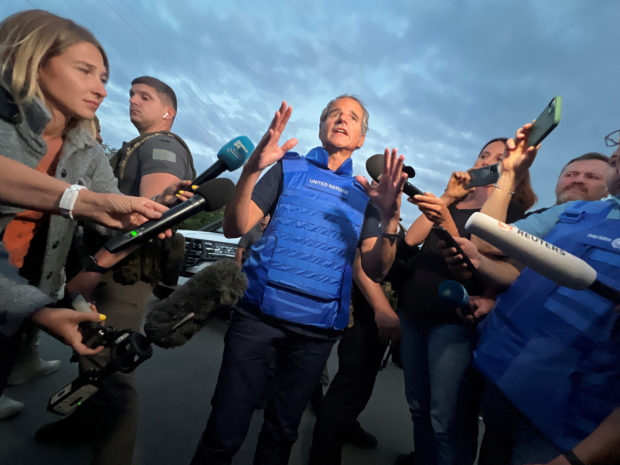
IAEA Director General Rafael Mariano Grossi speaks with journalists after he and a part of the International Atomic Energy Agency (IAEA) mission came back from a Zaporizhzhia nuclear power plant, amid Russia’s invasion of Ukraine, at a Ukrainian checkpoint in Zaporizhzhia region, Ukraine September 1, 2022. REUTERS/Anna Voitenko
ZAPORIZHZHIA, Ukraine — The U.N. nuclear agency chief said his experts were staying put after they crossed on Thursday into Russian-held territory in Ukraine and reached Europe’s biggest nuclear power plant, where both sides warn of potential catastrophe.
An International Atomic Energy Agency (IAEA) inspection team braved intense shelling to reach the Zaporizhzhia nuclear power plant, arriving after a delay of several hours in a large convoy with a heavy presence of Russian soldiers nearby.
“We are not going anywhere. The IAEA is now there, it is at the plant and it is not moving. It’s going to stay there,” IAEA head Rafael Grossi, who personally led the mission, told reporters after returning to Ukrainian-held territory.
He said a group of IAEA experts had stayed behind at the plant and would provide an impartial, neutral and technically sound assessment of the situation.
“I worried, I worry and I will continue to be worried about the plant until we have a situation which is more stable, which is more predictable,” he said.
Ukraine and Russia accuse each other of creating a risk of a Chernobyl-like disaster by shelling near the plant, where the situation has been unravelling in recent weeks. Russia seized the plant early in the now more than six-month-old war.
Kyiv also accuses Russia of using the facility to shield its forces, and of planning to steal its output by hooking it up to the Russian power grid. Moscow denies this but has so far rejected international calls to withdraw its troops from the plant.
Video footage released by Russia’s state news agency RIA showed IAEA inspectors, including Grossi, wearing safety helmets and being shown around the site by Russian energy officials, who pointed out what were described as damaged water pipes.
Russian Foreign Minister Sergei Lavrov said Moscow was doing everything to ensure that the plant could operate safely, and for the IAEA inspectors to be able to complete their tasks.
Earlier, Ukraine’s state nuclear company Energoatom said Russian shelling had forced the shutdown of one of the two reactors still operating at the site.
As the inspectors arrived at the frontline, Russian and Russian-installed local officials accused Kyiv of sending troops on boats near dawn to try to capture the plant on Thursday, and of shelling the nearby Russian-held city of Enerhodar.
Kyiv accused the Russians of staging those incidents to blame Ukraine and block the IAEA visit.
A Reuters reporter in Enerhodar said a residential building was struck by shelling there, forcing people to take cover in a basement. It was not possible to establish who had fired.
Reuters reporters in Ukrainian-held Zaporizhzhia city saw flashes in the sky of explosions in the morning.
The head of the International Committee of the Red Cross called for all fighting near the plant to stop, warning that little could be done to respond in the event of a potential nuclear leak.
“(It) will be difficult if not impossible to provide humanitarian assistance … and this is why fighting should stop,” Robert Mardini told a news conference during a visit to Ukraine on Thursday.
Vital asset
Since its capture by Russia in March, the plant has been controlled by Russian troops but operated by Ukrainian staff.
The plant sits on the south bank of a huge reservoir on the Dnipro River that divides Russian and Ukrainian forces in central southern Ukraine. Before the war, it supplied more than a fifth of Ukraine’s electricity.
In recent days, Ukraine has launched a major counter-offensive to recapture territory in southern Ukraine, mainly further down the Dnipro in neighboring Kherson province.
Ukrainian officials have welcomed the IAEA visit, expressing hope that it will lead to the demilitarization of the plant.
Russian-installed officials have suggested the team from the U.N. nuclear watchdog would have only a day to inspect the plant, while the mission had prepared for longer.
Energoatom head Petro Kotin said the IAEA visit would be successful if it led to the “demilitarization” of the facility. He said authorities were making “all efforts” to restart a plant reactor that shut down on Thursday due to shelling.
Both sides have claimed battlefield successes in the new Ukrainian push to recapture territory in the south, although details have been scarce so far, with Ukrainian officials releasing little information about their advance.
“It is a very slow process, because we value people,” said Oleksiy Arestovych, an adviser to Ukraine President Volodymyr Zelenskiy. Moscow has denied reports of Ukrainian progress and said its troops had routed Ukrainian forces.
Reuters could not independently verify those claims.
Millions of people have fled Ukraine, thousands have been killed and cities have been reduced to rubble in what Kyiv and the West call Russia’s unprovoked war of aggression.
Moscow calls its actions a “special military operation” to rid Ukraine of nationalists and protect Russian-speaking communities.
Children returned to desks in some areas for the start of the Ukrainian school year. Ukrainian children who fled the country also started new schools across central Europe for the first time on Thursday.
But in Mykolaiv near the frontline in southern Ukraine, children went to their bombed-out school only to take their books home. Most schools in the area will stay shut.
“My heart is broken because I love this school,” said Viktoria Poliakova, deputy head teacher, as she looked at the damage.